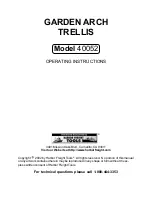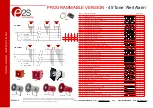
Page 3 of 16
v3.1
This range of external warning devices includes 3 models: 2 wired at Grade 2 & 3 and 1 wire-free at Grade 2 all are
Environmental class IV and can be installed in security systems in accordance with EN50131-1: 2006 + A1: 2009.
The wired models comply to EN50131-4: 2009, WD type Z; the wire-free model complies to EN50131-4:2009, WD type W.
These warning devices feature one piezo and one LED strobe for audible and visual indication of an alarm activation.
Each model includes the latest innovation in electronics and incorporates a lithium Ion battery for better reliability, each
of the wired versions incorporates a smart charging circuit to optimise the battery capability and battery life.
A number of other unique features are listed below.
d
eScrIptIon
F
eatureS
& o
ptIonS
Back-light
Only available on the PLUS version.
It is possible to select either ON or
ECO (default).
In the ON position the back-light is permanently ON. In the ECO
position the inbuilt light sensor will automatically switch the back-light off during the day, thereby reducing power
consumption.
Test
Confirmation
Only available on the PLUS and WIRE-FREE versions.
This feature allows the user to be notified before entering the premises that the intruder alarm system has generated
a confirmed alarm due to 2 or more detectors being activated.
During an alarm activation if a negative (0v) signal is applied to the confirmed input at the same time as a signal is
applied to the siren input the siren tone will change to a rapid tone every few seconds. If a signal is applied to the
strobe input, the strobe flash rate will also change. If the signal is removed from the confirmed input, the tone/flash
rate will revert back to the standard tone/flash rate.
If the signal is removed from the siren/strobe inputs the sounder will stop sounding/flashing regardless of a signal
being applied to the confirmed input.
Only available on the PLUS and WIRE-FREE versions.
If a positive signal is applied to this input it will start the test routine. At the start of the test the fault output terminals
will go open circuit. During the test the siren will sound for 3 seconds, strobe will flash for 3 seconds and battery will
be tested to ensure that all are functioning correctly. At the end of a successful test the Senza will make a low level
sound and the fault output terminals will change to a closed circuit.
If a fault is detected, the fault output terminals will stay open circuit until the fault has been rectified.
Trigger Monitoring
Only available on the PLUS version and is mandatory for all grade 3 installations.
When selected, the device monitors the siren and strobe trigger wire’s integrity by means of monitoring resistors.
These resistors are connected to the opposite signal that is required to activate the siren or strobe i.e. negative siren
trigger signal (default), the monitoring resistor is connected between a positive and the trigger wire in the control
panel. In the event of the siren trigger wire being cut or removed, the fault output circuit will open. In the event of the
strobe trigger wire being cut or removed the strobe will start to flash. The fault output circuit will NOT be activated.
Note:- Fitting the resistor in the warning device does not comply with grade 3 requirements.
Engineer Hold-off
During the first installation of the Senza this feature allows you to connect the on-board battery without the sounder
sounding, after hold-off voltage is applied the Senza will enter its normal mode. If Hold-off voltage is removed the
sounder will sound.
Fault
Only available on the PLUS and WIRE-FREE versions.
The 2 fault outputs are normally closed and will switch to an open circuit if a fault occurs with the sounder, strobe, and
battery. If trigger wire monitoring has been selected the fault output will also open circuit if a fault is detected. It also
acts as confirmation that the test procedure has been started by going open circuit and on a successful completion of
the test procedure the outputs will go closed circuit.
Volume
Each model will allow you to select the dB(A) level required to comply with the country/regional requirements it is
possible to reduce the sound output from 105dB(A) (
default
) to maximum sound output of 85dB(A)


































